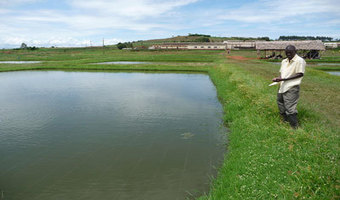A group of fish farmers in Embu County are championing the use of earthened ponds as an alternative to the prohibitively priced liners, to stop water loss from the ponds at a time when demand for fish is pushing more farmers to the venture but limited knowledge costing them.
The greatest problem for fish farmers is how to tame water from the ponds. Liner materials are particularly encouraged because they ensure minimum or no loss. The Ultra violet-treated Low-Density Polyethylene (LDPE) with a thickness of 0.5 mm is particularly used by those in large-scale fish farming.
The majority of smallholder farmers cannot afford this and have been courting the cheaper liner alternatives most of them second-hand sourced from greenhouses used by flower farms. The liners have a limited lifespan of only three months.
Related News: Meteoric demand for fish drives aquaculture farming
Related News: Innovation sees Zambian farm become Africa’s leader in aquaculture
But the effects on the fish have been toxic with some of these secondhand liners containing pesticides that have killed fish in the ponds. Martin Miako in Mbeere constituency of Embu County who decided to trial fish farming last year lost his entire fingerlings after using liners bought from a flower farm in Naivasha. “I just woke up one day to feed the fingerlings and found them floating helplessly in the pond,” he recalled painfully. His woes have been a common occurrence among a majority of the novice fish farmers in Embu.
The second-hand liners have also been tearing easily causing leakages in ponds. “The liners on my pond would tear easily especially if I stepped on it which I had to access the fish,” added Charity Murugi another fish farmer.
But the Wiyake Fish Farmers Association which has 60 members has perfected the art of mixing red soil with lime to create eathern ponds, with every member now enjoying fish farming and no water loss. Although the method is laborious and requires experience, the idea of having all members present while constructing the pond has helped equip each member with skills. Farmers have also been working with Fisheries officers from the County government.
The process begins with farmers mixing lime with the red soil and then adding water to make a fine sticky and thick paste similar to the one used to make mud houses. Lime is used because it makes the soil sticky and makes the pond alkaline creating a conducive environment for the fish.
Farmers then stick the paste on the surface, bottom, and sides of the pond. To smoothen the surface of the pond, the red soil and the agricultural lime is mixed with water into a thin paste at a ratio that compares with the fish pond size. The paste is then smeared and smeared over the surface to eliminate all spaces that might have been left during the initial plastering.
Related News: Greenhouse fish enable Meru farmers beat cold weather spurring fast maturity
“We also do a continuous sprinkling with water to ensure that the surface does not dry as we smoothen the surface of the pond,” said Mwangi Kihungi the group’s chairman.
The pond is then filled with water to the brim and the fingerlings are ready to be introduced into the pond.
“All our farmers have already adopted the earthen ponds and already enjoying fish farming. We hope to roll it out to even non-members of course at a fee across the county and beyond as a low-cost alternative to liners,” said Kihungi.
A 300 by 300 meters earthen pond requires on average Sh30,000 for the cost of construction materials and labour.
